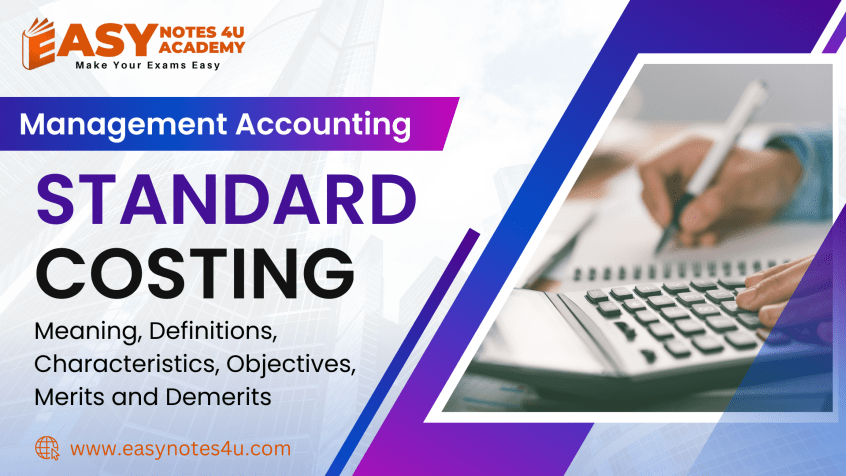
In this article we will discuss one of the important topic of Management Accounting – Standard Costing – Meaning, Definitions, Characteristics, Objectives, Merits & Demerits.
Standard costing is a management accounting tool used by organizations to establish predetermined costs and performance benchmarks for various activities within the production process. Here’s an overview of its meaning, definitions, concepts, objectives, merits, and demerits:
Meaning of Standard Costing in Management Accounting
Meaning of Standard Costing – Standard costing involves setting predetermined costs for materials, labor, and overheads based on expected levels of efficiency and costs. These standards serve as benchmarks against which actual costs and performance are compared.
Definitions of Standard Costing
Different sources may offer slightly varying definitions of standard costing in Management Accounting, but here are a few concise definitions from reputable management accounting textbooks:
- CIMA (Chartered Institute of Management Accountants):
- “Standard costing is the preparation and use of standard costs, their comparison with actual costs and the analysis of variances to their causes and points of incidence.”
- IMA (Institute of Management Accountants):
- “Standard costing is a management accounting technique used to establish predetermined costs, which are then compared with actual costs to evaluate performance.”
- Horngren’s Cost Accounting: A Managerial Emphasis by Charles T. Horngren, Srikant M. Datar, and Madhav V. Rajan:
- “Standard costing is a costing method that is based on the setting of predetermined costs for manufacturing inputs and for manufacturing overhead.”
Characteristics or Nature of Standard Costing
The characteristics or Nature of standard costing in Management Accounting encompass its fundamental attributes and features that distinguish it as a management accounting technique. Here are the key characteristics:
- Predetermined Costs: Standard costing involves the establishment of predetermined costs for materials, labor, and overheads based on expected levels of efficiency and costs.
- Comparison with Actual Costs: Actual costs incurred during production are compared with the predetermined standard costs to identify differences (variances).
- Variance Analysis: Variance analysis is a central aspect of standard costing, involving the examination of differences between standard costs and actual costs to understand the reasons behind deviations.
- Cost Control: Standard costing provides a systematic framework for cost control by setting benchmarks against which actual costs can be measured and managed.
- Performance Evaluation: It facilitates performance evaluation by comparing actual performance against predetermined standards, allowing managers to assess efficiency and effectiveness.
- Continuous Improvement: Standard costing encourages a culture of continuous improvement by highlighting areas where actual performance deviates from standards, thus identifying opportunities for enhancement.
- Decision Making Support: Standard costing provides relevant information for decision-making processes such as pricing, budgeting, and resource allocation, aiding managers in making informed choices.
- Motivation Tool: Well-designed standard costing systems can serve as a motivational tool for employees, as they provide clear performance targets and incentives for achieving or exceeding standards.
- Flexibility: While standards are predetermined, they should be regularly reviewed and revised to reflect changes in operating conditions, technology, and market dynamics, ensuring the system remains relevant and effective.
- Simplicity vs. Accuracy: Standard costing strikes a balance between simplicity and accuracy, aiming to provide a practical and manageable approach to cost management and performance evaluation.
Objectives
Objectives of Standard Costing – Management Accounting
- Cost Control: Standard costing helps in controlling costs by providing benchmarks for comparison.
- Performance Evaluation: It facilitates performance evaluation by comparing actual performance against predetermined standards.
- Decision Making: Provides relevant information for decision-making processes such as pricing, budgeting, and resource allocation.
- Motivation: Setting achievable standards can motivate employees to improve performance.
Merits
Merits of Standard Costing – Management Accounting
- Cost Control: Provides a systematic approach to cost control by setting predetermined standards.
- Performance Evaluation: Facilitates performance evaluation by comparing actual performance against standards.
- Decision Making: Provides timely and relevant information for decision-making processes.
- Motivation: Can motivate employees to meet or exceed standards, leading to improved efficiency.
- Simplicity: Standard costing is relatively easy to implement and understand compared to other costing methods.
Demerits
Demerits of Standard Costing – Management Accounting
- Rigidity: Standard costs may become outdated if not regularly reviewed and updated.
- Complexity: Developing and maintaining accurate standards can be time-consuming and complex.
- Variances: While variances provide valuable insights, they may not always reflect actual inefficiencies or improvements.
- Incentive Distortion: Setting overly challenging standards can demotivate employees if they are perceived as unattainable.
- Focus on Cost: Overemphasis on cost variances may lead to neglect of other important aspects of performance such as quality and customer satisfaction.
Discover more from Easy Notes 4U Academy
Subscribe to get the latest posts sent to your email.
